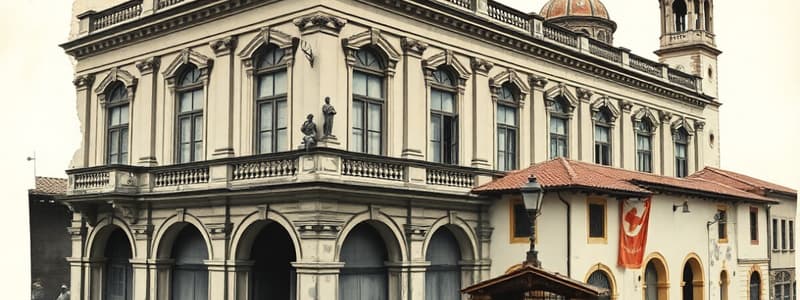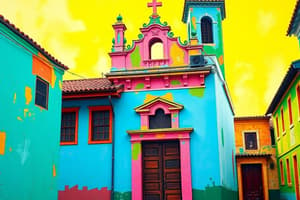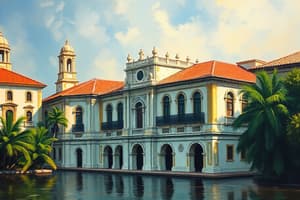Podcast
Questions and Answers
What title were Filipino builders known by during the Spanish era?
What title were Filipino builders known by during the Spanish era?
Maestro de Obras
There were civil engineering schools in the Philippines during the Spanish era.
There were civil engineering schools in the Philippines during the Spanish era.
False (B)
Who founded the City of Manila?
Who founded the City of Manila?
Miguel Lopez de Legaspi
What was one of the early constructions by the Franciscan Order in Manila?
What was one of the early constructions by the Franciscan Order in Manila?
What is the oldest stone church in the Philippines?
What is the oldest stone church in the Philippines?
When was the construction work for the Santiago fortress completed?
When was the construction work for the Santiago fortress completed?
Which fortification was breached by British forces in 1762?
Which fortification was breached by British forces in 1762?
The baluarte was restored after the British occupation.
The baluarte was restored after the British occupation.
What major natural event damaged the baluarte in 1863?
What major natural event damaged the baluarte in 1863?
The military structure Nuestra Senora de Guia was renovated in _____.
The military structure Nuestra Senora de Guia was renovated in _____.
Flashcards are hidden until you start studying
Study Notes
Spanish Era
- During the Spanish era, Filipinos were not allowed to be civil engineers.
- Filipino construction workers were called Maestro de Obras, equivalent to Construction Foreman today.
- Spanish architects and engineers were the only ones with academic degrees.
- The walled city of Intramuros served as a model community built by Spaniards.
- Friar Architects/Engineers built government buildings, bridges, and residences, incorporating European standards.
- During the 18th and 19th centuries, Filipino engineers maintained, repaired, and remodeled infrastructure systems in towns.
- Maestro de Obras built structures in villas and mansions for the elite.
Notable Structures
- Miguel Lopez de Legaspi founded the City of Manila in 1571.
- Fort Santiago construction began in 1571.
- The Franciscan Order in 1577 began building churches out of wood and cane that were destroyed by natural disasters.
- A stone church funded by public charity was built in 1739.
- Nuestra Senora de Guia was built as a circular fort from 1586 to 1587 by Jesuit priest Antonio Sedeno, one of the oldest stone fortifications in Intramuros.
- It was renovated in 1593 to join the city walls.
- Fort fell in disrepair in 1644 and a new baluarte was added and completed in 1663.
- The fort was damaged by British forces in 1762 and during an earthquake in 1863. It was destroyed during the Battle of Manila in 1945.
- Construction on the Santiago castle/fortress began in 1591 and was completed in 1634, the second most important stone fortress in Manila.
- The Santiago fortress was built from 1596 - 1602, the most important fortification in Manila and the starting point for the city walls.
- St. Augustine Church, the oldest stone church in the Philippines, began construction in 1599 and was destroyed and rebuilt numerous times.
- In 1621, San Sebastian Church was built on land donated by Don Bernardino Castillo.
- The original wood church was burned down in 1651 and the succeeding structures were destroyed by fire and earthquakes in 1859, 1863, and 1880.
Studying That Suits You
Use AI to generate personalized quizzes and flashcards to suit your learning preferences.




